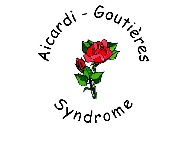Meeting with Prof. Aicardi 2000
THE INTERNATIONAL AICARDI-GOUTIERES SYNDROME ASSOCIATION

I.A.G.S.A.
Minutes of the
INTERNATIONAL AICARDI-GOUTIERES SYNDROME ASSOCIATION’ S
Meeting with Prof. Aicardi on 12/06/2000 at the C.Mondino Neurological Institute.
Those present:
- Prof. Aicardi
- Prof. Lanzi
- Prof. Fazzi
- Mrs Boni
- Several Italian and German families
Mrs Boni opened the meeting, reminding those present of the aims of the newly established association:
- to raise public awareness and spread knowledge of Aicardi-Goutières syndrome;
- to provide sufferers from this disease and their families with support through contact with doctors and health organizations internationally;
- to promote and support research in the area of problems specifically linked with Aicardi-Goutières syndrome.
Prof. Aicardi was then asked to outline the current situation as regards international research into the disease.
Prof. Aicardi divided current research into three sectors:
1. Clinical approach
Efforts are being made to collect and analyse all the information available on cases of the syndrome. Such information could be used to develop a precise diagnostic method and would make it easier to establish a protocol of investigations.
(Interferon-alpha/Liquor (spinal fluid), Iymphocytos,s, etc. ..)
2. Genetic research
Although this research was begun only just over a year ago, it has already started producing results. In some samples, it has been possible to identify a sector of chromosome 3 presenting anomalies. Research must now continue, and focus on efforts to isolate the defective gene. However, it has been seen that not all samples present the said anomaly, which means that this syndrome appears to be heterogeneous. Research must therefore seek to highlight the other genetic defects that underlie this pathology.
3. Study of pathological mechanisms
These research studies have sought to clarify the role of interferon-alpha, and an American team has artificially raised interferon-alpha levels in mice, and shown that the animals, like children affected by the syndrome, develop calcifications and cerebral atrophy. This shows that a raised interferon level could be one of the causes of the onset of these symptoms, but it does not clarify the reasons for this raised level. Moreover, it is considered highly probable that raised interferon is an effect, rather than the cause of the disease. Research conducted by the French and Dutch groups, that aims to highlight the mechanisms underlying this anomaly, is to continue.
A parent asked how widespread the disease is.
Prof. Aicardi does not have any precise data on this; no real statistics are available on the diffusion of the disease. The French group has seen 32 cases, while the English one has seen 23 cases in 13 families. As the syndrome has also been observed in different ethnic groups, there does not appear to be a link with ethnic background.
Another parent asked about relations between the various research groups.
Prof. Aicardi pointed out that, for the time being, relations between the various research groups have not been coordinated or formalized in any way, and that the involvement of other specialists, such as immunologists, equipped to investigate other aspects of the disease, could also prove necessary.
The question was raised whether there exists a correlation between the level of interferon-alpha and the severity of the disease.
In Prof. Aicardi’s view, no such correlation exists, partly because the interferon level is a constantly evolving parameter: the level of interferon depends very much on when the sample was taken. Certainly, in this disease, the level falls with increasing age, which means that older children will have lower interferon levels. Prof. Aicardi feels that the discovery of a direct correlation between interferon-alpha and disease severity would be surprising.
A parent asked whether, in the light of current knowledge. It might be possible to develop a treatment. For example, if a raised interferon-alpha level causes damage, would it not be possible to develop a treatment to control it?
Prof. Aicardi expressed the view that a treatment of this kind is not an impossible prospect, but that it would have to be evaluated extremely carefully. The altered interferon level were, in fact, an effect and not the cause of the disease, it would be necessary to make absolutely sure that lowering it would not be harmful, upsetting other biochemical balances. Consideration might be given to a third hypothesis, in other words, that IFN-a and AGS are two independent manifestations of the same unknown cause. Specialists from other sectors would therefore have to be involved before any kind of treatment could be tested.
A parent asked Prof. Aicardi whether some of the symptoms of the disease, demyelinization, calcifications, atrophy, are inked with the age of the children.
Prof. Aicardi confirmed that the syndrome can be regarded as a progressive illness, at least for the first few years. It is not known whether it later settles into an established pathological state. This is a question to which it is not possible to give a definite answer: there are not enough precise reports available, there are too few cases of the syndrome, and the study of’ the disease is still too much in its infancy (the first case was diagnosed only 15 years ago).
Prof. Aicardi suggested that the association might look for a way of contacting French families.
Prof. Lanzi suggested that the association should meet again next year, aiming next time to involve other physicians or specialists who might be interested in studying this syndrome.
Finally, it was pointed out that the role played by the association is essential as pharmaceutical companies and private individuals are unlikely to become sufficiently interested in this syndrome to invest funds into the study of it: it affects so few subjects that it does not constitute an viable financial proposition. Research in this field can be coordinated and developed only by an association of doctors and families.
As no other questions were forthcoming, the meeting was drawn to a close. Prof. Aicardi meanwhile confirmed that he would be available the following day to examine and discuss the individual cases present.







